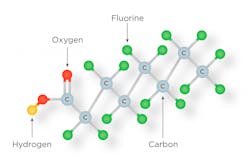Everyone is beginning to learn about an entire group of chemicals called PFAS: Per- and Polyfluorinated Alkyl Substances which are actually 4700 plus PFAS chemical compounds. They are showing up regularly in the news these days, and firefighters seem to be at ground zero for many of the stories. Professor Graham Peaslee, Professor of Physics at the University of Notre Dame, was scheduled to speak about how PFAS chemicals affect first responders at FDIC International 2020 (Fire Department Instructors’ Conference).
Professor Peaslee has been explaining the basics of what these PFAS chemicals are, how they work, where they are used, and why there are so many concerns about them and human health. PFAS in Class B Foam (AFFF), Class A Foams and Wetting Agents are toxic exposure concerns to firefighters as well as the fate of PFAS in the environment. Research and testing are being completed, together with an assessment of what can be done to minimize firefighter exposures and the cleaning of PFAS contaminated apparatus.
The Foam Exposure Committee (FEC) has been involved in obtaining nearly 200 firefighting foam samples for testing from around the United States and Canada. The FEC Committee is still actively seeking firefighting foam samples to test for total fluorinated (PFAS) content. Fluorinated (PFAS) firefighting foams have proven to be a toxic issue to human health, the environment and especially water supplies yet they continue to be manufactured, distributed and used.
The mission of the committee is: to reduce firefighter/first responder exposures to PFAS chemicals used in firefighting foams in order to protect their health and lives. We will determine which firefighting products contain PFAS and those that are fluorine-free.
Our first responders should have immediate access to safer fluorine-free firefighting foams.
Learn more about PFAS here.






